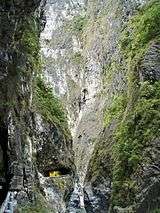Eight Views of Taiwan

Taroko Gorge
The Eight Views of Taiwan (Chinese: 臺灣八景) have been talked about at different times in Taiwan's history.[1]
Under Japanese Rule
In 1927 (during Japanese rule), the Taiwan Nichinichi Shimpō (Japanese: 臺灣日日新報) reported the Eight Views of Taiwan as:
- Rising Sun Hill (旭岡), now Sun Yat-sen Park, Keelung
- Tansui
- Eight Immortals Mountain
- Sun Moon Lake
- Alishan
- Ape Hill
- Cape Eluanbi
- Taroko
Republic of China
The latest version of the Eight Views of Taiwan was defined by the ROC Ministry of Transportation in 2005:
- Taipei 101
- National Palace Museum, Taipei
- Sun Moon Lake
- Alishan
- Yushan
- Kaohsiung Love River
- Kenting
- Taroko National Park
References
- ↑ Eight Views of Taiwan (Baidu Encyclopedia) in Chinese
See also
- Eight Views in China, Japan and Korea
- Eight Views of Xiaoxiang
- Eight Views of Jinzhou (Dalian)
- Eight Views of Lushun South Road, Dalian
- Eight Views of Omi, Japan
- Eight Views of Korea
- Thirty-six Views of Mount Fuji, by Hokusai and Hiroshige
This article is issued from Wikipedia - version of the 6/25/2016. The text is available under the Creative Commons Attribution/Share Alike but additional terms may apply for the media files.